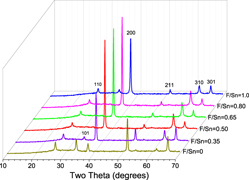Crossref Citations
This article has been cited by the following publications. This list is generated based on data provided by
Crossref.
Knapp, Caroline E.
and
Carmalt, Claire J.
2016.
Solution based CVD of main group materials.
Chemical Society Reviews,
Vol. 45,
Issue. 4,
p.
1036.
Malik, Oleksandr
and
Hidalga-Wade, Francisco Javier De la
2017.
Optoelectronics - Advanced Device Structures.
Malik, Oleksandr
Hidalga-Wade, Francisco Javier De La
and
Amador, Raquel Ramírez
2017.
Pyrolysis.
KALELİ, Murat
ALDEMİR, Durmuş Ali
BAYRAM, Ahmet Buğrahan
and
YAVRU, Celal Alp
2019.
Ultrasonik Sprey Piroliz ile Üretilen Flor Katkılı Kalay Oksit İnce Filmlerin Yapısal, Morfolojik, Optiksel ve Elektriksel Analizleri.
Düzce Üniversitesi Bilim ve Teknoloji Dergisi,
Vol. 7,
Issue. 3,
p.
2107.
Ramírez-Amador, Raquel
Flores-Carrasco, Gregorio
Alcántara-Iniesta, Salvador
Rodríguez González, Julio
García-Teniza, Ogilver
Mercado-Agular, Eduardo
and
Vásquez-Ortiz, Arturo Benito
2019.
Structural, Morphological, Optical, and Electrical Characterization of Fluorine Doped Tin Oxide (FTO) Thin Films Synthesized by PSP.
Solid State Phenomena,
Vol. 286,
Issue. ,
p.
64.
Li, Bao-jia
Yang, Guang-yu
Huang, Li-jing
Zu, Wei
and
Ren, Nai-fei
2020.
Performance optimization of SnO2:F thin films under quasi-vacuum laser annealing with covering a transparent PET sheet: A study using processing map.
Applied Surface Science,
Vol. 509,
Issue. ,
p.
145334.
Abdel-Galil, A.
Moussa, N. L.
and
Yahia, I. S.
2021.
Synthesis and optical characterization of nanocrystalline fluorine-doped tin oxide films: conductive window layer for optoelectronic applications.
Applied Physics A,
Vol. 127,
Issue. 6,
SAĞLAM, Hilal Kübra
SARITAŞ, Sevda
and
ERTUGRUL, Mehmet
2021.
Effect of Various Precursors on ZnO Thin Films by USP Technique.
Erzincan Üniversitesi Fen Bilimleri Enstitüsü Dergisi,
Vol. 14,
Issue. 3,
p.
926.
Latif, Hamid
Liu, J.
Mo, D.
Wang, Rui
Zeng, J.
Zhai, P.F.
and
Sattar, Abdul
2021.
Effect of Target Morphology on Morphological, Optical and Electrical Properties of FTO Thin Film Deposited by Pulsed Laser Deposition for MAPbBr3 Perovskite Solar Cell.
Surfaces and Interfaces,
Vol. 24,
Issue. ,
p.
101117.
Sağlam, Hilal Kübra
Masat, Mehmet
and
Ertuğrul, Mehmet
2022.
SnO2 ultra-thin film gas sensor fabricated by ultrasonic spray pyrolysis (USP) method.
Vol. 2506,
Issue. ,
p.
080003.
Ramírez-Amador, Raquel
Alvarado-Pulido, José Joaquín
Martínez-Hernández, Haydee Patricia
Cortes- Maldonado, Raúl
Alcántara-Iniesta, Salvador
Flores-Carrasco, Gregorio
Ojeda-Durán, Esteban
Malik, Oleksandr
Morales-de la Garza, Leonardo
Méndez-Rojas, Miguel Ángel
Panecatl-Bernal, Yesmin
Luna-López, José Alberto
and
López-Salazar, Primavera
2023.
Study of fluorine-doped tin oxide thin films deposited by pneumatic spray pyrolysis and ultrasonic spray pyrolysis: a direct comparison.
Materials Research Express,
Vol. 10,
Issue. 6,
p.
066402.
Kim, Jaewon
2024.
Texture changes of fluorine-doped tin oxide (FTO) coatings using ultrasonic spray pyrolysis.
Ceramics International,
Vol. 50,
Issue. 20,
p.
38342.



